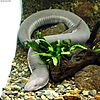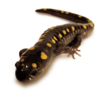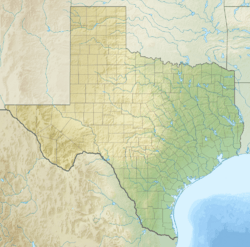List of amphibians of Texas facts for kids
Seventy-two amphibian species are found in the American state of Texas, including forty-four species of frog and twenty-eight species of salamander. Four species are categorized as endangered by the International Union for Conservation of Nature: the Barton Springs salamander, the Texas blind salamander, the black-spotted newt, and the Houston toad. Furthermore, Texas law protects several native amphibians, designating eleven species as threatened within the state and four others as endangered.
The varied geography of Texas, the second-largest state, hosts a variety of habitats for amphibians, including swamps and the Piney Woods in the east, rocky hills and limestone karst in the central Hill Country of the Edwards Plateau, desert in the south and west, mountains in the far west (the Trans-Pecos), and grassland prairie in the north, also known as the Panhandle. This vast contrast in biomes makes Texas home to a wide variety of herpetofauna. The state's many rivers, including the Rio Grande, the Colorado River, and the Trinity River, also provide diverse aquatic habitats. Its central position in the United States means that species found primarily in either the western or eastern reaches of the country often have their ranges meeting in the state. Additionally, its proximity to Mexico is such that many species found there and into Central America also range as far north as Texas. Moreover, the karst topography of central Texas has created spring and cave ecosystems inhabited by several endemic species, such as the cave-dwelling Texas blind salamander.
Contents
List of species
| Threatened | |
| Endangered |
Order Anura
Family Bufonidae
Bufonidae is a family of toads, often called the "true toads". Although a widely varied family, Bufonidae includes the stereotypical toad: dry warty skin and shortened forelimbs and hindlimbs. Bufonids also carry potent skin toxins, sometimes concentrated in the parotoid gland.
| Species | Common name | Distribution | Status | Image |
|---|---|---|---|---|
| Anaxyrus americanus | American toad | Occurs in northeast Texas |  |
|
| Anaxyrus cognatus | Great Plains toad | Found in playa wetlands in the Great Plains area of the state |  |
|
| Anaxyrus debilis | Green toad | Found in eastern Texas |  |
|
| Anaxyrus houstonensis | Houston toad | Found in the southeast counties of Austin, Bastrop, Burleson, Colorado, Lee, Leon, Lavaca, Milam, and Robertson |  |
|
| Anaxyrus punctatus | Red-spotted toad | Found in central and western Texas |  |
|
| Anaxyrus speciosus | Texas toad | Common throughout western two-thirds of Texas, population declining in the Rio Grande Valley |  |
|
| Anaxyrus woodhousii | Woodhouse's toad | Found in central, west and north Texas |  |
|
| Incilius nebulifer | Coastal plains toad | Found along coastal plains, formerly considered the same species as Incilius valliceps |  |
|
| Rhinella marina | Cane toad | Native to extreme southern Texas, invasive species in other parts of the United States |  |
Family Hylidae
Hylidae is a family of frogs which are commonly found in the New World. They may be better known as tree frogs.
| Species | Common name | Distribution | Status | Image |
|---|---|---|---|---|
| Acris blanchardi | Blanchard's cricket frog | Found throughout Texas, except far West Texas and the Panhandle |  |
|
| Acris crepitans | Northern cricket frog | Found as far west as western Texas |  |
|
| Dryophytes arenicolor | Canyon tree frog | Isolated populations in arid environments and streambanks in Texas |  |
|
| Dryophytes chrysoscelis | Cope's gray tree frog | Documented in east-central Texas |  |
|
| Dryophytes cinereus | Green tree frog | Occurs throughout eastern Texas and as far south as the Rio Grande Valley |  |
|
| Hyla squirella | Squirrel tree frog | Found in eastern Texas |  |
|
| Dryophytes versicolor | Gray tree frog | Found in the eastern-central portion of the state, excluding the most eastern fifth |  |
|
| Pseudacris clarkii | Spotted chorus frog | Found in central Texas | ||
| Pseudacris crucifer | Spring peeper | Found in eastern Texas |  |
|
| Pseudacris fouquettei | Cajun chorus frog | Found throughout eastern Texas |  |
|
| Pseudacris streckeri | Strecker's chorus frog | Found throughout eastern Texas |  |
|
| Smilisca baudinii | Mexican tree frog | Southern extreme of Texas |  |
Family Leptodactylidae
Leptodactylidae is a family of frogs found only in the New World. Texas encompasses part of their northern-most distribution. Medium to large frogs, they have robust hindlimbs that make them strong jumpers.
| Species | Common name | Distribution | Status | Image |
|---|---|---|---|---|
| Craugastor augusti | Eastern barking frog | Found in western and central Texas and along the Balcones Fault; isolated populations exist in the Trans-Pecos region |  |
|
| Eleutherodactylus cystignathoides | Rio Grande chirping frog | Native to extreme southern Texas along the lower Rio Grande Valley in Cameron and Hildago counties |  |
|
| Eleutherodactylus guttilatus | Spotted chirping frog | Found in the Big Bend region |  |
|
| Eleutherodactylus marnockii | Cliff chirping frog | Common in rocky areas of central Texas |  |
|
| Eleutherodactylus planirostris | Greenhouse frog | Introduced species found on Galveston Island |  |
|
| Leptodactylus fragilis | Mexican white-lipped frog | Documented in the extreme southern portion of the lower Rio Grande Valley |  |
Family Microhylidae
Microhylidae is a family of frogs. They can often be identified by their tear-dropped shape, hence the common name "narrow-mouthed frogs".
| Species | Common name | Distribution | Status | Image |
|---|---|---|---|---|
| Gastrophryne carolinensis | Eastern narrowmouth frog | As far west as central Texas |  |
|
| Gastrophryne olivacea | Great Plains narrowmouth frog | Found throughout Texas except for northern Panhandle and western extremes |  |
|
| Hypopachus variolosus | Mexican narrow-mouthed frog | Found in 15 counties in southern Texas |  |
Family Ranidae
Ranidae, true frogs, are the largest family of frogs. Members of this family, called Ranids, typically have robust hindlimbs, toe webbing, and an aquatic tadpole stage.
| Species | Common name | Distribution | Status | Image |
|---|---|---|---|---|
| Lithobates areolatus | Crawfish frog | Once found throughout eastern Texas, now limited to two populations near coast |  |
|
| Lithobates berlandieri | Rio Grande leopard frog | Occur in central and western areas of the state |  |
|
| Lithobates blairi | Plains leopard frog | Distribution includes northern Texas |  |
|
| Lithobates catesbeianus | Bullfrog | Occurs throughout most of Texas |  |
|
| Lithobates clamitans | Green frog | Throughout eastern Texas |  |
|
| Lithobates grylio | Pig frog | Galveston Bay and Gulf Coastal Plain to the east |  |
|
| Lithobates palustris | Pickerel frog | Found throughout eastern Texas |  |
|
| Lithobates sphenocephala | Southern leopard frog | Common in the eastern third of Texas |  |
Family Rhinophrynidae
Rhinophrynidae are a family of frogs containing only one extant genus, the monotypic Rhinophrynus. Rhinophrynus is a burrowing ant and termite eater, hence the common name "burrowing frog".
| Species | Common name | Distribution | Status | Image |
|---|---|---|---|---|
| Rhinophrynus dorsalis | Mexican burrowing toad | Documented in the counties of Starr and Zapata in extreme southwestern Texas |  |
Family Scaphiopodidae
Scaphiopodidae are a family of frogs. Commonly called spadefoot frogs, they are often inconspicuously coloured. Members of this family are predominantly fossorial, living underground until rain arrives. To aid in digging, they have keratinized protrusions on their feet.
| Species | Common name | Distribution | Status | Image |
|---|---|---|---|---|
| Scaphiopus couchii | Couch's spadefoot toad | Central Texas |  |
|
| Scaphiopus hurterii | Hurter's spadefoot toad | Inhabits freshwater areas of Texan forest, shrubland, grassland, and wetlands |  |
|
| Spea bombifrons | Plains spadefoot toad | Found in the arid plains of northwest Texas; isolated populations also exist in south Texas |  |
|
| Spea multiplicata | New Mexico spadefoot toad | Found in central Texas |  |
Order Urodela
Family Amphiumidae
Amphiumidae are a family of salamanders. Members of the family are known as amphiumas. These large salamanders are often mistaken for eels, hence the colloquial name "conger eels". Completely aquatic, these long salamanders can survive droughts by forming a mucous cocoon underground. They can live without food for up to three years and may live for almost 30 years.
| Species | Common name | Distribution | Status | Image |
|---|---|---|---|---|
| Amphiuma tridactylum | Three-toed amphiuma | Native to the eastern area of the state |  |
Family Salamandridae
Salamandridae are a family of salamanders. Most members, called salamandrids, produce a potent toxin in their skin. Salamandrids typically have patterns of bright and contrasting colors, usually to warn potential predators of their toxicity. They have four well-developed limbs.
| Species | Common name | Distribution | Status | Image |
|---|---|---|---|---|
| Notophthalmus meridionalis | Black-spotted newt | Found in southern Texas |  |
|
| Notophthalmus viridescens | Eastern newt | Native to eastern Texas |  |
Family Ambystomatidae
Ambystomatidae is a family of mostly terrestrial salamanders. Commonly called "mole salamanders", most members of this family live in rodent burrows, only emerging on rainy nights to mate and feed. These relatively large salamanders also typically have mass migrations to mating ponds.
| Species | Common name | Distribution | Status | Image |
|---|---|---|---|---|
| Ambystoma maculatum | Spotted salamander | Found near stagnant water in hardwood and mixed forests |  |
|
| Ambystoma mavortium | Barred tiger salamander | Distributed throughout Texas except eastern quarter |  |
|
| Ambystoma opacum | Marbled salamander | Found throughout East Texas, from Red River south to the Gulf of Mexico |  |
|
| Ambystoma talpoideum | Mole salamander | Found in the Gulf Coastal Plain of east Texas | ||
| Ambystoma texanum | Smallmouth salamander | Eastern Texas |  |
|
| Ambystoma tigrinum | Eastern tiger salamander | Distributed throughout Texas except eastern quarter |  |
Family Plethodontidae
Plethodontidae are a family of salamanders found mostly in the Western Hemisphere; however, some species are found in Southern Europe and South Korea. They are the largest group of salamanders. Several species of salamanders are endemic to specific cave systems in Texas. Due to their small habitat and specified role, many are threatened or endangered. In 2019, researchers associated with the University of Texas Austin and Texas Parks and Wildlife announced the discovery of an additional three species of spring and cave dwelling salamanders in the Eurycea genus that are yet to be named.
| Species | Common name | Distribution | Status | Image |
|---|---|---|---|---|
| Desmognathus auriculatus | Southern dusky salamander | As far east as the Trinity River Basin |  |
|
| Eurycea latitans | Cascade Caverns salamander | Endemic to the Cascade Caverns of central Texas and other cave systems in close proximity | ||
| Eurycea nana | San Marcos salamander | Found only in the San Marcos River in Hays County |  |
|
| Eurycea naufragia | Georgetown salamander | Endemic to area northeast of the Colorado River in the Edwards Plateau region of central Texas |  |
|
| Eurycea neotenes | Texas salamander | Spring and cave systems in the Edwards Plateau region of central Texas | ||
| Eurycea quadridigitata | Dwarf salamander | Found in eastern Texas |  |
|
| Eurycea rathbuni | Texas blind salamander | Only lives in water-filled caves in the Edwards Plateau in Hays County |  |
|
| Eurycea robusta | Blanco blind salamander | Unknown, single specimen found in subterranean system under Blanco River in Hays County | ||
| Eurycea chisholmensis | Salado Springs salamander | Endemic to area northeast of the Colorado River in the Edwards Plateau region of central Texas | ||
| Eurycea sosorum | Barton Springs salamander | Found only at outlets of Barton Springs in Zilker Park, Austin |  |
|
| Eurycea tonkawae | Jollyville Plateau salamander | Endemic to the Buttercup Cave system near Austin |  |
|
| Eurycea tridentifera | Comal blind salamander | Endemic to Honey Creek Cave in Comal County and other caves in Cibolo Sinkhole Plain | ||
| Eurycea troglodytes | Valdina Farms salamander | Endemic to springs and cave systems in the counties of Bandera, Edwards, western Kerr, Medina, Real, and Uvalde | ||
| Eurycea waterlooensis | Austin blind salamander | Known only from outflows of Barton Springs in Austin | ||
| Eurycea pterophila | Fern bank salamander | This species inhabits springs within the watershed of the Blanco River | ||
| Plethodon albagula | Western slimy salamander | Disjunct, and genetically divergent, populations in central, southeastern, and northeastern Texas |  |
|
| Plethodon serratus | Southern red-backed salamander | Although there are several populations throughout the southeast US, this species is only known in Texas from a single specimen collect in Nacogdoches County in 1940 |  |
Family Sirenidae
Sirenidae are a family of aquatic salamanders only found in northern Mexico and the Southeastern United States. Family members, called sirens, have very small forelimbs and lack hind limbs altogether. Sirens are generally regarded as the most primitive extant salamanders.
Family Proteidae
Proteidae are a family of aquatic salamanders only found in North America and Europe. Some members are called mudpuppies, waterdogs, or olms. They are paedomorphic and exhibit laterally compressed tail fins and the red, filamentous external gills. Only one species of Proteidae is found in Texas.
| Species | Common name | Distribution | Status | Image |
|---|---|---|---|---|
| Necturus beyeri | Gulf Coast waterdog | Found in the Sabine River System |  |
See also



